A Guide to RISC OS Hardware
RISC OS 2 was first released in 1989, and since then there have been many different machines capable of running the OS. Despite that, there have probably never been more options available than there are now, thanks to the success that has been achieved porting RISC OS 5 to different hardware platforms over the past decade. While we don’t claim that this is an exhastive list of what is available, we welcome updates and corrections!
If you’re coming new to RISC OS, then we would suggest either looking at emulation or at one of the low-cost hardware options: the Raspberry Pi makes a very capable system, as well as having some ready-made images to install on to an SD card.
More information about the different versions of RISC OS mentioned below can be found in our guide to RISC OS versions and our brief history of RISC OS.
Emulators
Emulation is an ideal way to use RISC OS if you already have access to a ‘mainstream’ computer. It allows RISC OS to run as another application, alongside your day-to-day software, and to easily share files between the systems – not to mention things like the monitor, keyboard and mouse!
There are downsides, of course: all of your eggs end up in one hardware basket, and many people prefer to have a ‘proper’ RISC OS computer on their desk. In the end, it’s a personal choice.
RPCEmu
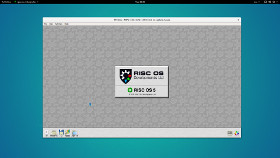
RPCEmu is an Open Source emulation of the venerable RiscPC, which can be used on Windows, Mac OS and Linux systems. Whilst the virtual hardware that it mimics might be long in the tooth, it also brings plenty of backwards-compatibility with old software – and there’s no requirement to emulate 1990s processor speeds!
This compatibility means that RPCEmu can run either the ‘26-bit’ RISC OS 4 and Six along with all of the software that would have worked on a real RiscPC in the 1990s, or the very latest ‘32-bit’ builds of RISC OS 5. It’s even possible to have two systems side by side on your desktop, giving the best of both worlds.
RPCEmu is free, although on non-Windows platforms you might need to build it yourself. For those without licenced copies of RISC OS to hand, RISC OS 5 can be downloaded free from RISC OS Open. Copies of RISC OS 4 and Six are available to buy from 3QD Developments for £5 and upwards.
- RPCEmu
- RISC OS 5 for a RiscPC can be downloaded free from RISC OS Open
- RISC OS 4 and Six can be purchased from 3QD Developments
Virtual Acorn
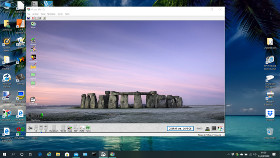
If you would prefer a commercial emulator, then the Virtual Acorn range might be more your thing. Available for the Windows and Mac OS platforms, VirtualRPC can simulate a number of different RiscPC systems and supports the use of the ‘26-bit’ RISC OS 4 and Six. In addition, a VirtualA5000 product can pretend to be hardware from 1991 – which will only run RISC OS 3.1.
Depending on your budget, the range from Virtual Acorn themselves starts at £49. Alternatively, VirtualA5000 (which is limited to running RISC OS 3.1) and VirtualRPC-DL (which is limited to running RISC OS 4.02) can be purchased from 3QD Developments for £15 and £25 respectively.
For those looking for new hardware, preconfigured Windows-based systems can be bought from suppliers including R-Comp. Their RISCube, SpaceCube and RISCBook range of machines come ready to run both RISC OS and Windows as a ‘hybrid’ computer.
- VirtualRPC is available from Virtual Acorn
- VirtualRPC-DL and VirtualA5000 are available from 3QD Developments
- RISCube, MiniCube, SpaceCube and RISCBook systems are available from R-Comp
Native Hardware
If you want some ’real’ hardware to run RISC OS on, there are plenty of options available. Unless you’re looking second-hand, then all the solutions require RISC OS 5 – although if you’re new to the system, without a collection of old software that you would like to use, that isn’t going to be a significant hardship.
There are a number of companies offering RISC OS hardware. These range from collections of component parts to ready-to-go desktop computers, and much in between – if you’re looking for a system, it pays to do some research first and decide what suits you best.
The Raspberry Pi

Launched in 2012, the Raspberry Pi is a diminutive ARM-based system created by the Raspberry Pi Foundation to promote the use and understanding of computers. RISC OS 5 runs natively on all of the models released to date, and there are ready-made SD card images available to plug in and go for many of them. When combined with its low price, it makes an ideal platform for experimenting with RISC OS.
Whilst RISC OS Open provide standard ROM images, it will probably be easier for a newcomer to install RISC OS from either the RISC OS Pi or RISC OS ePic SD cards available to buy from their store. Alternatively, the RISC OS Direct SD card image from RISC OS Developments is free and can be used alongside introductory video tutorials if you’re new to the platform.
Despite its low price, the system is very usable and many existing RISC OS users are adopting it as an everyday machine. Several RISC OS companies, including R-Comp, RISCOSbits and CJE Micro’s, produce pre-built systems (including Pi-Top-based laptops) for those wishing to spend a bit more.
- The Raspberry Pi
- RISC OS Pi and RISC OS ePic SD card images from RISC OS Open
- RISC OS Direct SD card image from RISC OS Developments
- Packaged systems from R-Comp, RISCOSbits and CJE Micro’s
The Pinebook
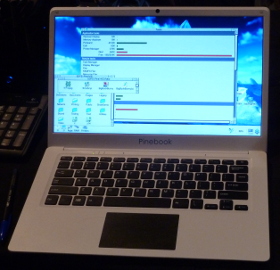
For those who want a portable RISC OS system, the Pinebook is an obvious choice. Based around a Cortex-A64, with 2GB RAM and a 1080p display, it’s the first native ARM portable to run RISC OS since Acorn released the A4 in the early 1990s. The ARM’s legendary frugality with power gives the system an extremely competitive battery life, and many RISC OS users are finding that it makes a very usable day-to-day system.
Given the support required for the laptop hardware, R-Comp’s ready-to-go ARMbook is an obvious choice and includes a customised build of RISC OS 5. Systems can also be purchased from RISCOSbits.
Development work continues: RISC OS doesn’t support WiFi, but USB-attached interfaces provide a workaround whilst this is resolved. In the meantime, the ARMbook already provides a definite alternative to running an emulator on a mainstream laptop for those who need RISC OS on the go!
- The ARMbook is available from R-Comp and RISCOSbits
- The Pinebook
The Titanium motherboard

Released in late 2015, the Titanium is a standard DTX form-factor ARM motherboard based around an AM5728 Cortex-A15 processor. Designed with the intention of giving RISC OS a future-proofed base on which to build, it contains 2GB RAM, dual DVI outputs, Gigabit Ethernet, SATA and more besides.
Designed and sold by Elesar, the bare board is available to buy direct for self-build projects. A version of RISC OS 5 can be supplied pre-programmed into the board, and updates are available direct from RISC OS Open.
For those who aren’t so keen on the DIY approach, the motherboard forms the basis of the TiMachine, Titan and TiX Duet from R-Comp and the RapidO Ti from CJE Micro’s.
- The Titanium is designed and sold by Elesar
- RISC OS 5 for a Titanium can be downloaded free from RISC OS Open
- The TiMachine, Titan and TiX Duet are available from R-Comp
- The RapidO Ti is available from CJE Micro’s
The Wandboard
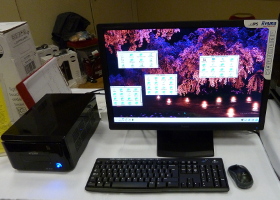
RISC OS runs on a number of ARM development boards, one of which is the i.MX6-based Wandboard. Based around a Cortex-A9 processor, it has 2GB RAM, high resolution (up to 2560×1440) HDMI video, Gigabit Ethernet and more.
As with the Titanium, it's possible to either build your own Wandboard-based system or buy a a ready-made one. R-Comp released the ARMX6 in early 2015, and RISCOSbits will make up a Qadro to order.
A version of RISC OS 5 which runs in the Wandboard can be downloaded from RISC OS Open, although users of the ARMX6 are strongly recommended to get their updates from R-Comp.
- The Wandboard
- The ARMX6 is available from R-Comp
- The Qadro is available from RISCOSbits
- RISC OS 5 for a Wandboard can be downloaded free from RISC OS Open, but ARMX6 users are recommended to use R-Comp releases
The Mini.m (or CuBox-i)
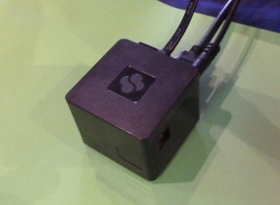
Based on the CuBox-i from SolidRun, the R-Comp Mini.m must be one of the smallest computers around. Fitting into a 2-inch cube, it’s small enough to fit into a pocket with ease.
The system is based around the same Cortex-A9 processor as the Wandboard-based ARMX6, the board features 2GB RAM, 4K HDMI video, Gigabit Ethernet, up to 200GB internal storage and an eSATA connection. It runs RISC OS 5, with a suitable version supplied by R-Comp.
For those wishing to expand beyond what the existing connectors will allow (within the 2-inch cube limitation), RISCOSbits sell the mini.dock range to give more room for growth.
- The SolidRun CuBox-i
- The Mini.m is available from R-Comp
- Mini.docks are available from RISCOSbits
The IGEPv5
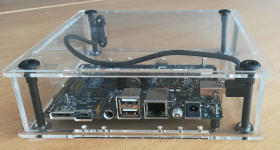
Another development board which has turned into a number of desktop systems is the IGEPv5 from ISEE. Based around a 1.5GHz Cortex-A15 processor, the board has 4GB RAM (of which RISC OS can use 2GB at present), high resolution (up to 2048×1440) HDMI video, SATA and Ethernet.
The board forms the basis of the the RapidO Ig, from CJE Micro’s. For those preferring a more DIY approach, a range of cases are available from RISCOSbits.
A version of RISC OS 5 (referred to as ‘OMAP5’) is available direct from RISC OS Open.
- The IGEPv5
- RapidO Ig is available from CJE Micro’s
- IGEPv5 cases are available from RISCOSbits
- RISC OS 5 for an OMAP5 IGEPv5 can be downloaded free from RISC OS Open
The Pandaboard
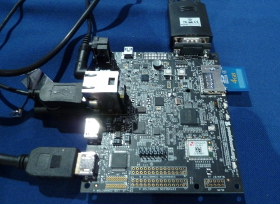
One of the early development boards taken up by RISC OS users as the basis for a desktop system, the Pandaboard offered a Cortex-A9 processor running at 1.2GHz, 1GB of RAM, HDMI video at 1920×1200, 100Mbit networking and USB.
As feedback from users of the DIY solutions helped the port of RISC OS 5 to stabilise, a number of companies started to offer ready-made desktop systems based around MiniITX cases and similar. R-Comp produced the ARMiniX, whilst CJE Micro’s still produce versions of the PandaRo.
A version of RISC OS 5 for the Pandaboard (referred to as ‘OMAP4’) is available direct from RISC OS Open, and alternative cases can be obtained from companies like RISCOSbits.
- PandaRo is available from CJE Micro’s
- ARMiniX was once available from R-Comp
- RISC OS 5 for an OMAP4 Pandaboard can be downloaded free from RISC OS Open
- Pandaboard cases are available from RISCOSbits
Older hardware
Whilst the systems listed above are still available new, there are more that are still in reasonably current use. You might encounter these being sold second-hand, or see references to them being used by contributors to forums and the like.
The Beagleboard and Beagleboard xM
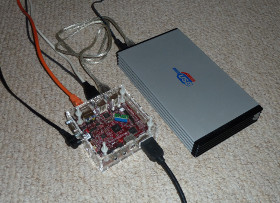
The ‘original’ development boards used for RISC OS, the Beagleboard and Beagleboard xM were instrumental to relaunching the native hardware market in the early 2010s. Based around a Cortex-A8 processor running at 800MHz or above, the boards came with 512Mbytes of RAM, DVI and HDMI video support (albeit with limited resolutions or refresh rates), 100Mbit networking and USB.
Initially popular as a DIY solution with users looking for an upgrade to the by-then decade-old Iyonix PC, over the years a number of companies have produced finished desktop systems by fitting the boards into a MiniITX case with the necessary additional peripherals – including the ARMini from R-Comp and the BIK from a4com.
Whilst the machines are no longer available new, there are still many in use – and a suitable version of RISC OS 5 (referred to as ‘OMAP3’) is available direct from RISC OS Open. For those still wishing to give a bare board a home, cases are available from companies like RISCOSbits.
- The Beagleboard and Beagleboard xM
- ARMini was once available from R-Comp
- RISC OS 5 for an OMAP3 Beagleboard can be downloaded free from RISC OS Open
- Beagleboard cases are available from RISCOSbits
The Iyonix PC
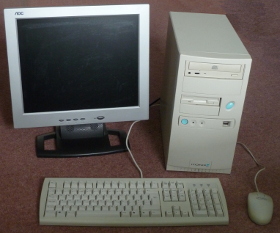
The first 32-bit RISC OS 5 machine, the Iyonix PC was released by Castle Technology in late 2002 and began the platform’s move away from obsolete and increasingly hard to source 26-bit-capable ARM processors.
Using a 600MHz XScale processor and 1GB RAM, with Gigabit networking built in, the Iyonix was – at the time – the fastest system to run RISC OS natively. Built on a standard ATX-format motherboard, it had support for PCI expansion cards (which it used for graphics and USB as standard) as well as being the last system able to take Acorn-style podules.
The Iyonix PC came in a number of desktop, tower and cube cases, and continued to be sold until 2008. These days they are still popular machines, but fussiness over their power supplies can lead to some reliability and maintenance issues. Second-hand systems can be found from a number of RISC OS dealers.
- RISC OS 5 for an Iyonix PC can be downloaded free from RISC OS Open
The A9home
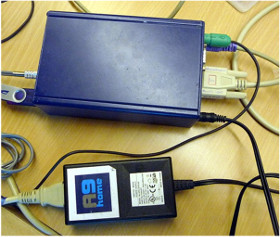
The A9home was the second 32-bit RISC OS system to be released but, unlike the Iyonix PC, it used a 32-bit version of RISC OS 4.42 dubbed “Adjust32”. Developed by Advantage 6 and marketed by CJE Micro’s, it came in a small blue box which set a pattern for many of the systems which would follow.
The diminutive size hid a well-featured machine, comprising a 400MHz ARM9 processor, 128Mbytes of SDRAM, 8Mbytes Video RAM and a 40Gbyte hard disc. Communication with the outside world is via USB, RS232 serial, PS/2, audio in/out and 10/100Mbit network ports. The USB support is USB1.1 only.
Due to its compact size, neither the RAM nor the hard disc could be upgraded, and despite running a variant of RISC OS 4, the 32-bit processor meant that it had all the same compatibility issues as RISC OS 5. The machine suffered from the faltering progress at RISCOS Ltd, and it never managed to fully shake off its ‘pre-release’ status. This was in stark contrast to RISC OS 5 systems, which so far all continue to receive the latest OS updates from RISC OS Open.
The RiscPC
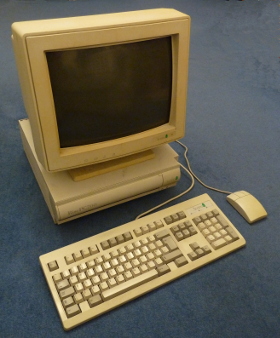
Released in 1994, the, RiscPC is the last of Acorn’s machines to remain really useful. Its expandability – in particular the ability to change the processor with the swap of a daughtercard – has meant that many are still in use today. Generally those which survive are fitted with a StrongARM (usually clocked at 200-300MHz) or a Kinetic (a StrongARM with additional fast RAM fitted on the processor card, developed by Castle Technology in 2000). Machines fitted with ARM710 and ARM610 processors are still around, but are generally too slow to be productive with modern software.
The fact that the RiscPC is the last native system to run in 26-bit mode may have helped this longevity, since it can still run software that isn’s compatible with modern processors. It can use any version of RISC OS from 3.5 onwards, although most have been upgraded to RISC OS 4 or Six. It’s also possible to install RISC OS 5, although this isn’t common due to the reduced compatibility that 32-bit mode brings (the RiscPC version of RISC OS 5 is more usually found in RPCEmu).
In terms of expansion, RiscPCs take up to 256Mbytes of memory in the form of SIMMs, plus up to 2Mbytes of Video RAM (upgrades for the latter are very hard to come by). An on-board IDE interface can take two devices, but its age makes it hard to find hard discs which are compatible and third-party IDE expansion podules are popular. Networking was via an expansion card, and 10/100Mbit interfaces were available – although the motherboard prevented full 100Mbit from being achieved. Viewfinder and Vpod podules offered higher quality video output and support for more modern screen resolutions than the original hardware.
Historical computers
RISC OS has been around since 1989, and the original machines that it ran on were launched in 1987, so there are plenty of older systems around. While much older hardware is probably of historical interest only, some of the more recent systems can still be useful in sime cases. That said, for serious desktop use today, a machine listed under native hardware (above) should be considered a more practical choice.
Some of the machines listed here were developed by third-parties after Acorn’s demise, but the majority were designed and developed by Acorn themselves before their breakup in 1998.
The Omega
The Microdigital Omega was launched in 2002, and was seen as a competitor to the Iyonix PC. Although there are a number of satisfied users still around, few were made and development of all the specified add-ons was never completed.
The system was based around a StrongARM processor, with custom hardware comprising a number of FPGAs to emulate the IO systems of a RiscPC; Acorn expansion podules were not supported. It could support up to 1Gbyte of RAM. The Omega initially shipped with RISC OS 4.03, and could be upgraded to later versions of RISC OS 4.
The Mico and R7500, Networkx and Scorcher
The Mico, from Microdigital, and the R7500, Networkx and Scorcher series, from RiscStation, were two ranges of ARM7500-based computers released in the late 1990s. Both systems shipped with RISC OS 4.03.
All the systems are capable of running modern software, but can not physically accept Acorn expansion podules. Performance could seem limited to those familiar with even a RiscPC.
A7000 and A7000+
Aside from the RiscPC, these were the only Acorn-developed machines which could run RISC OS 3.5 or better. Based around the ARM7500 and ARM7500+ respectively, they were similar in spec to the Mico and R7500 series machines and were produced in the second half of the 1990s.
Although capable of running the same software as a RiscPC, their expansion capabilities were limited and their support for modern screen resolutions is lacking.
A3010, A3020 and A4000
The one-box A3010 and A3020 (with the keyboard in the same box as the computer itself) and the A4000 with a conventional separate keyboard were based around the ARM250 series of processors and finished production in around 1995.
Compared to modern systems they were slow, and they could only be used with RISC OS 3.1 – this rules them out for a lot of modern software. Expansion capabilities were limited.
A300, A400, A500 series, A3000, A5000 and A4
This final group of machines are the oldest in this list. Based around the ARM2 and ARM3 processors (with all being capable of an upgrade to ARM3 if not already fitted), they shipped with RISC OS 3.1, RISC OS 2 or (in the case of those made before 1989) the original Arthur OS. Most would have been upgraded to RISC OS 3.1 during their life.
Expansion capability varied: most could accept up to four podules, but the one-box A3000 could only manage a single one mounted in an external case. As would be expected for machines designed before 1990, they are very slow by modern standards and RISC OS 3.1 limits the software that they can run.
The A4 was Acorn’s only laptop machine, and was effectively an A5000 in a laptop case. Running RISC OS 3.1, it came with additional support for the battery and 15-level greyscale display.
More details
If you have any questions about RISC OS hardware, why not drop us a line?







